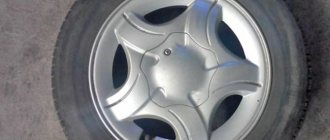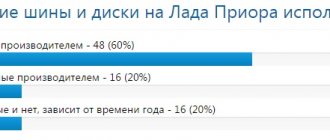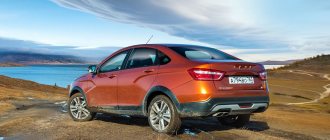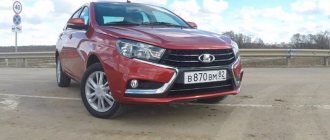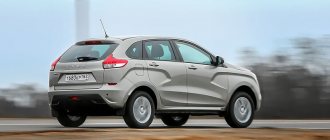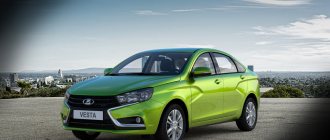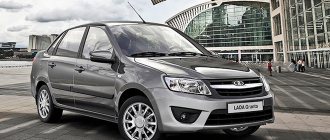- Guys, I took this off last night! — our photographer Dima boasts in the morning.
Indeed, even the aborigines will not remember such bright flashes of the northern lights. And Andrei Mokhov and I slept through everything exhausted. After all, in a week on the tracks of the Swedish Arctic Falls training ground we need to test 22 sets of winter tires! But in the final protocol, 21 models of size 205/55 R16 remained. Why? I'll tell you now.
How are tires selected for our comparative tests? Before testing, we send requests to tire companies asking them to provide one or two sets. And since the tests are carried out at the end of the winter season - this year in mid-March - some companies already have new models ready for production. We take these with pleasure - in order to provide our readers with up-to-date information about these tires in the fall. But we reserve the right to check its authenticity - to conduct a so-called doping test. This year we also had to resort to checking - and for good reason.
We carried out the tests at one of the seven test sites at the Arctic Falls test site: here, on an area of about five hectares, all the tracks necessary for winter tire testing are compactly laid out
The list of participants in our test included 13 studded and nine non-studded models. The bias towards studs is due to statistics, because more than 70 percent of Russian drivers choose “nails”. The hot new products in this class are the Korean Hankook Winter i*Pike RS2 tires and the Japanese Yokohama iceGuard iG65 tires. Both of them followed the “Scandinavian” path of development - they increased the number of studs following the example of the successful models Continental IceContact 2 and Nokian Hakkapeliitta 9. But where is Michelin with the new model X-Ice North 4, which also noticeably increased in studs? Alas, they refused to provide us with these tires, and we did not find them on sale.
Ice is a very capricious coating. To obtain objective results, the measurement cycle must be repeated several times.
Among the beginners, there are also those who have chosen the traditional number of studs - 115-130 pieces per 16-inch tire. These are the Japanese models Toyo Observe Ice-Freezer, Firestone Ice Cruiser 7 and the Chinese-Singapore GT Radial IcePro 3, as well as the Russian Cordiant Snow Cross 2 tires, which are not included in the final protocol.
On ice and snow, measurements on each set of tires are performed 12-16 times. There are half as many races on asphalt: the surface is more stable
In the non-studded class, the main intrigue is the duel between the new Continental VikingContact 7 and Nokian Hakkapeliitta R3. Or maybe fresh Asian models - Yokohama iceGuard iG60 and Hankook Winter i*cept iZ2 - will intervene in their dispute? By the way, it is here, at the Swedish Arctic Falls test site (translated from English as “Arctic Falls”), that Bridgestone and Yokohama rent sites for their winter tests.
Overhang (the protrusion of the studs above the tread surface) is the most important parameter for winter tires. If it is less than a millimeter, the tires will probably fail on ice
Autoreview published the results of a large test in which winter studded and friction winter tires of size 225/50 R17 were tested. In the final, the tire ratings were divided into two categories, however, as it turned out, if you carefully study the points scored at the finish line, some non-studded tires can give a head start to tires with studs.
However, let's start from the very beginning. The damn dozen models presented in the test basically explain why it is called large. But taking into account the division into studs and “non-studs” (in a ratio of six to seven), the test, by and large, only leaves readers guessing as far as size is concerned, and even more so those who know about the annual tests of Auto Bild winter tires, in which, for example, in 2022, 53 sets of tires took part.
Taking into account the dominance of Nokian and Continental products among the participants, as well as the absence of tires from the Goodyear and Michelin brands, the new Pirelli and Dunlop, or at least Kumho in an updated version, the relevance of this Autoreview test is questionable.
The Michelin company allegedly refused to participate in the test literally a week before it began; why not, history is silent about the rest. But that's okay, other 2022 winter tire tests cover these gaps.
There are also questions about the size chosen for the test. Calling 225/50 R17 “pop” is a stretch.
List of tested winter studded tires:
- Continental IceContact 3 - new for the winter season 2019/2020
- Gislaved Nord*Frost 200
- Hankook Winter i*Pike RS2 W429
- Nokian Hakkapeliitta 9
- Nokian Nordman 7
- Yokohama iceGuard iG65
List of tested winter friction tires:
- Bridgestone Blizzak Ice - debut in tests
- Continental Viking Contact 7
- Hankook Winter i*Cept iZ2 W616
- Nokian Hakkapeliitta R3
- Nokian Nordman RS2
- Toyo Observe GSi-6 - new for the winter season 2019/2020
- Yokohama iceGuard iG60
It is noteworthy that four of the six presented studs had an increased number of “steel teeth”.
Autoreview 2019 test results
Weather surprises presented a unique opportunity for the test group to feel the difference in tires at three different temperatures: -20°C, -10°C and +6°C. Moreover, in the latter case, tests were carried out on ice, and not on wet asphalt.
Rating of winter studded tires 2021-2021
Rating of winter studded tires 2021-2022 from Autoreview:
- Nokian Hakkapeliitta 10P,
- Michelin X-Ice North 4,
- Goodyear UltraGrip Arctic 2,
- Pirelli Ice Zero 2,
- Hankook Winter i*pike RS2.
Rating of winter studded tires 2021-2022 from Za Rulem:
- Nokian Hakkapeliitta 10 - new for the 2021/2022 season
- Michelin X-Ice North 4
- Hankook W429 Winter i*Pike RS2
- Nokian Nordman 8 - new for the 2021/2022 season
- Pirelli Formula Ice
- Yokohama iceGuard iG65
- Goodyear UltraGrip 600
- Tigar Ice
Continental IceContact 2 SUV – studded tires for crossovers and SUVs
If you have a crossover or jeep, pay attention to the Continental IceContact 2 SUV winter tires. The rubber holds up well on any surface, including icy conditions. Quiet, soft, the steering response increases with it, the chassis works better.
Moderately noisy winter tires, comfortable, a good option for both big cities and trips out of town. High-quality braking on dry and wet asphalt, in this quality there are practically no differences with studless tires. It runs and brakes well in the snow, and has good cross-country ability in slush. It walks and brakes confidently on ice and packed snow, there is no rutting on the asphalt, and there are no lateral stalls.
- low noise; road grip; softness; holds the road in ice and snow; reliability.
- high price; Soft sidewall but still durable.
Test of winter studded tires from Autoreview
, Michelin and Nokian tires handled ice braking and acceleration best . Everything is logical: the more studs on the tire, the better, especially when there is an icy surface under the wheels.
But in the snow, where little depends on the studs, the new Goodyear , demonstrating both better acceleration dynamics and better braking properties. But when assessing cross-country ability with traction control turned off in first gear, the test Volkswagen Passat plowed through freshly fallen snow about 6 cm deep most confidently on Nokian Hakkapeliitta 10P . However, the rest lost a little.
The asphalt races also turned out to be realistic: the cleared roads made it possible to evaluate the braking properties on wet asphalt during the thaw, and we did the brakes on a dry surface at a temperature of minus 8°C. In both cases, Pirelli Ice Zero 2 , but even with them, the braking distance from a speed of 100 km/h on dry asphalt is almost ten meters longer than on summer tires.
But you shouldn’t forget about comfort either. And here the new products win: Goodyear UltraGrip Arctic 2 and Nokian Hakkapeliitta 10P are noticeably quieter than tires of previous generations. But the Pirelli or Hankook studs make a noticeable noise.
The result is that miracles do not happen: Nokian Hakkapeliitta 10P and Michelin X-Ice North 4 are in the lead. But if you don’t drive on ice often, then Pirelli Ice Zero 2 or Goodyear UltraGrip Arctic 2 are also very good options.
The former are more suitable for city dwellers, while the latter are especially good on compacted snow, that is, on provincial roads. Michelin X-Ice North 4
Tread pattern based on the “nine”, studs are still of two types - for the central part with triangular inserts, for the side tracks with Y-shaped ones. But the studs themselves have become smaller, and their number has increased from 190 to 220 in 16-inch tires. This made it possible to reduce the gap on ice to the leader of recent years - Michelin X-Ice North 4 .
Nokian Hakkapeliitta 10 EV
The optimization of the tread pattern is also noticeable in tests on loose snow: when slipping, the Hakkapeliitta 10P tires paddle better than others! And if the previous generation Hakkapeliitta was one of the “loudest” on the market, then the “ten” is the quietest tire in this test. The Finns claim that in other dimensions the stud arrangement is optimized for better acoustic comfort. And the Nokian Hakkapeliitta 10 EV , intended for electric vehicles, are covered on the inside with a layer of porous polyurethane. Such tires are not much more expensive than regular ones and are available only in large sizes - starting from 18 inches.
Michelin X-Ice North 4 tires are only slightly ahead of the new Nokian Tires tires on ice, within the measurement error, but what’s more important is that they better inform the driver about slippage. The development of these slips is smooth, making it easier for the driver to correct them and drive the car along the optimal trajectory. The result is a victory in the ice slalom and the highest score for ease of control.
But on compacted snow, the directional tread does not work so confidently - apparently, this is due to both the smaller area of the tread grooves and their shallowest depth among the test participants. That, however, did not prevent us from showing a decent result in loose snow.
On asphalt - average grip properties, but good handling. And decent acoustic comfort: there are a lot of spikes, but they are noticeably smaller, and their inserts are ordinary cylindrical, and not figured, like those of competitors. Therefore, French tires “sing” at higher frequencies that are not irritating to the ear, albeit a little louder than Nokian tires.
Pirelli Ice Zero 2
The Pirelli Ice Zero 2 was introduced two years ago. The classic directional tread pattern is reinforced with 190 shaped studs in the form of ticks, opening in the direction of deceleration. Indeed, there are no special problems with braking on ice, and with acceleration too. But in the transverse direction, the Pirelli tires do not hold up so well and slip rather abruptly. Not surprisingly, they had the worst time in the slalom. And Italian tires don’t shine on packed snow, although they help you get out of snowdrifts no worse than Michelins.
But most of all, Pirelli winter tires pleased us on asphalt - both on wet and dry surfaces, head and shoulders above the competition. And in last year’s tests, these tires also demonstrated high resistance to aquaplaning (AR No. 18, 2020). This allows us to recommend Ice Zero 2 tires primarily to residents of large cities. But with one caveat - you will have to put up with increased noise levels throughout the entire speed range.
Goodyear UltraGrip Arctic 2
We had to wait almost ten years Goodyear UltraGrip Arctic 2 studded tires The tread pattern is still directional, but not as linear, the number of studs in 16-inch tires has increased from 130 to 190, and the “nails” have a flattened carbide core. When braking on ice and in slalom, the lag is only behind the two leaders, but during acceleration the performance is more modest - apparently, this is due to the slightly rounded “acceleration” side of the insert.
But on snow, Goodyear studs are traditionally strong, especially since the width of the main grooves has become a little wider and they are “cut” deeper than those of other test participants. And now the obsessive hum when rolling is gone. And the family softness when rolling is present, for which we love Goodyear summer tires - these tires dampen disturbances from small irregularities better than their competitors. But at the same time, they do not shine with grip properties on asphalt - those who like active driving on cleared city avenues are unlikely to like them.
Hankook Winter i*pike RS2
Korean tires Hankook Winter i*pike RS2 still fall short of the leaders. The worst thing is with braking on ice: there seem to be no fewer studs than on Pirelli or Goodyear, but the car slows down worse. However, there are no particular problems during acceleration and cornering. And on snow, Hankook tires are not particularly behind the competition.
And on the asphalt they are even pleasing - only Pirelli is better than them. But they put pressure on the ears: at a speed of 80-90 km/h an unpleasant sound pulsation appears. For use on premium cars, you must agree, this is not the best recommendation, but for a limited budget it is an acceptable option. After all, the price tag for Hankook tires is one and a half times lower than for Nokian.
Results of the test of winter studded tires from Autoreview:
| Options | Weight of the indicator | Goodyear | Hankook | Michelin | Nokian | Pirelli |
| Ice | 35% | |||||
| — Braking properties | 15% | 9 | 8 | 10 | 10 | 9 |
| — Accelerating dynamics | 10% | 8 | 8 | 10 | 9 | 8 |
| - Handling (time on track) | 5% | 9 | 9 | 10 | 10 | 9 |
| — Ease of management | 5% | 8 | 8 | 10 | 9 | 8 |
| Snow | 15% | |||||
| — Braking properties | 10% | 10 | 8 | 9 | 9 | 8 |
| — Accelerating dynamics | 5% | 10 | 9 | 8 | 9 | 8 |
| Passability in deep snow | 10% | 9 | 9 | 10 | 10 | 10 |
| Wet asphalt | 10% | |||||
| — Braking properties | 10% | 8 | 8 | 8 | 8 | 10 |
| Dry asphalt | 10% | |||||
| — Braking properties | 10% | 8 | 9 | 9 | 9 | 10 |
| Comfort and efficiency | 20% | |||||
| — Acoustic comfort | 10% | 6 | 5 | 7 | 8 | 5 |
| — Smooth ride | 5% | 9 | 7 | 8 | 8 | 8 |
| -Rolling resistance (coast) | 5% | 8 | 9 | 10 | 10 | 9 |
| Overall rating | 100% | 8.5 | 8 | 9.1 | 9.1 | 8.6 |
Conclusion on the test of winter studded tires 2021/2022 from Autoreview
This is what the real TOP of winter studded tires for the 2021-2022 season looks like.
To compile a more current rating of winter studded tires for 2021-2022, five models of winter studded tires in size R16 were tested. The winner of the test was the Nokian Hakkapeliitta 10P studded winter tire. During testing, it impressed with better ride quality on ice and snow, high steering precision, dynamic handling characteristics in all weather conditions and short braking distances on wet and snowy roads.
Also exemplary: Michelin X-Ice North 4 . Goodyear UltraGrip Arctic 2, Hankook Winter i*pike RS2 and Pirelli Ice Zero 2 tires were rated “good”.
Tests
Driving a car on a winter road requires greater concentration, experience and knowledge from the driver, since it includes all types of weather conditions: sun, rain, snow and ice. Thanks to modern technologies, it was possible to create the weather conditions necessary for the test at the winter testing ground. A special heating system melted the ice in front of the pits and the entrance to the frozen lake, and a special “vacuum cleaner” raked, swept and blew snow off the track. The weather also helped - on the eve of the cross-country ability test it started snowing.
To measure the performance when driving on wet roads, it was decided to return to Sweden in April, but to another testing ground - in the city of Gislaved. There, not far from the buildings of the former tire factory of the same name, there is a testing ground with several tracks, one of which is equipped with the irrigation system necessary for this test.
Test of studded winter tires from Za Rulyem
Eight sets of studded tires of size 205/55 R16, the most popular among owners of golf-class cars, went head to head in the first comparative test of 2022 by the Russian publication Behind the Wheel. Among the test participants were representatives of various price categories, including two new products for the upcoming winter season from Finnish tire manufacturers.
A significant dispersion both in price (more than twice) between the cheapest and most expensive tires in the test, and in the number of anti-skid studs even before reading the results, allows us to roughly estimate the final rating.
However, the main intrigue of the test lies in a new round of struggle for the quantity and quality of studs: will the tenth generation of Hakkapeliitta be able to beat the winner of the previous ZR test of studs of the same size, in particular, the obscenely “toothy” Michelin XIN4 model.
List of tested winter studded models:
- Yokohama iceGuard iG65
- Tigar Ice
- Pirelli Formula Ice
- Nokian Nordman 8 - new for the 2021/2022 season
- Nokian Hakkapeliitta 10 - new for the 2021/2022 season
- Michelin X-Ice North 4
- Hankook W429 Winter i*Pike RS2
- Goodyear UltraGrip 600
All “white” tests of studded tires by the publication Behind the Wheel were carried out in Lapland back in February 2022 at temperatures from -13°C to -5°C, while the “asphalt” disciplines were carried out in April in Pirkanmaa (Finland) at +2°C…+7°C.
Features of the studded tire test
In both cases, the events were carried out on a Volkswagen Golf (in size 205/55 R16) at the testing grounds of Nokian Tires, so the products of this brand, as they say, “were helped by the walls.” This is where the attentive reader will catch himself thinking that the outcome of the test is predetermined, and specialists who know the underbelly of the “tire kitchen” and the long-standing “friendship” of the Russian publication and the Nokian Tires company will probably not even doubt this.
By the way, we note that there are two versions of Nokian Hakkapeliitta 10 passenger tires. One version with a special index in the name Hakkapeliitta 10p, created exclusively for the markets of Russia, Belarus and Kazakhstan). For other markets, including Ukraine, the company produces tires in a version without the “p” index in the name. Unfortunately, representatives of the Nokian Tires company did not clarify in response to our request what the actual difference between the models is, but most likely they differ in the height of the studs.
Results of the winter studded tire test from Za Rulyem
Winter studded tire test 2021/2022 - Behind the
Wheel Ice test results
The longitudinal grip properties of the new product in the Hakkapeliitta line from Nokian Tires are slightly superior to those of Michelin studs. Goodyear tires have the worst braking efficiency, while Tigar tires have poor acceleration performance. The difference with the discipline leader in both cases is more than 30%.
In lateral grip properties, the X-Ice North 4 had the advantage, while Tigar products were in the rear here too.
In terms of handling on ice, the Michelin tires earned the highest score, ensuring safe and understandable behavior of the test vehicle. At the same time, the testers emphasized that you just want to “trot” on Nokian tires, while a certain tendency of these tires to skid can greatly confuse inexperienced drivers, and for those who have been driving the steering wheel for many years, this small feature of the HKPL10 (literally) “does not poses no danger." But the performance of Goodyear and Tigar tires on an icy track did not make the right impression on the experts.
Snow test results
The efficiency of acceleration and braking for the majority of participants in the Behind the Wheel 2022 test was, plus or minus, the same. Tigar tires again shepherded the rear, although with a lag of only 10%, that is, in general, the differences in results on snow are not as great as on ice.
When driving in a straight line and smoothly maneuvering at 100 km/h, all the studs behaved decently; complaints were made against the Formula tires due to the inhibited reactions to steering turns, as well as Yokohama (on them the steering wheel is sticky and heavy) and Goodyear (and on On these tires the steering wheel is a bit empty and light).
On the snowy track, the Michelin and Nokian tires showed good handling, while the Goodyear tires kept sliding off the set trajectory even at low speeds. The greatest difficulties arose with the test VW Golf, “shod” in Yokohama products.
In general, according to the test results, a pattern can be seen: the more studs, the more confident the behavior of the tires. Tires of previous generations with 118 and 130 studs are absolutely not capable of seriously competing with their more “prickly” rivals. In tandem with Hakkapeliitta 10 and Michelin XIN4, it is not possible to single out a clear leader.
Continental ContiWinterContact TS850 - the best winter non-studded tires (2017 - 2018)
Among studless winter tires, the leader is the Continental ContiWinterContact TS850. According to reviews, these are truly quiet, comfortable tires with good handling and grip. It holds the track in heavy snow, and on ice there is also good grip for non-studded tires.
Excellent tires for those who prefer silence and comfort when driving in the winter season. The tires are soft, comfortable, without a sporty bias; they drive on asphalt without snow at almost summer speeds. Slower in deep snow or slush. Directional stability is above average, response to steering movements is moderate.
- quiet; good handling; grip with the road; comfort.
- some sizes are difficult to find; not suitable for driving in deep snow or slush; they skid; average directional stability.
Hankook Winter i*cept iZ2
PROS: It performs well on snowy roads, does not dig up or slip.
MINUSES Compared to studded tires from the same manufacturer, Winter i*cept iZ2 looks rather pale: only eighth place in the “Autoreview” rating and fifth according to test results of the Ukrainian site “Autocenter”. The tire demonstrates rather poor handling performance on both asphalt and ice.
Conclusion: not the cheapest tire with mediocre performance.
Cordiant Winter Drive – budget studless winter tires (Velcro)
Among studless tires, the so-called Velcro tires, in the budget category, according to reviews from car owners, Cordiant Winter Drive took pride of place. Almost silent, it moves and brakes well in slush, loose and compacted snow. On ice it behaves somewhat weaker, however, in city conditions good handling is maintained.
Completely predictable behavior of a car with Cordiant Winter Drive tires, abrasion-resistant, soft, with good tread, but at temperatures from 5 degrees above zero it begins to “float”. An excellent option for a quiet winter ride; it handles well in the snowdrifts.
- predictable behavior on various surfaces; does not wash off; soft; good tread; acceptable cost.
- braking on ice is worse; somewhat noisy for a non-studded shoe; floats at temperatures above +5.
Yokohama iceGuard iG55
ADVANTAGES : The tire handles snow-covered roads quite confidently, which allows it to be used not only in the city, but also outside it. Low cost. Good placement of the studs.
CONS Comparison with Finnish and German models is not in favor of the Japanese tire. Very poor performance both on asphalt and on icy roads. Quite noisy.
Conclusion: suitable for snowy roads. Inexpensive and not the most comfortable option.
Nexen WinGuard WinSpike WH62
PROS: Low cost combined with confident behavior on asphalt. The tire has a high level of noise comfort - it is practically inaudible.
CONS Can't boast good grip on snowy and icy roads. Handling also leaves much to be desired.
Conclusion: for its price, this tire is quite good if you use it on a clean asphalt surface. Suitable for southern regions or for northwestern regions, where winter is similar to European.
Nokian Tires Hakkapeliitta R2 SUV - studless tires: review "Autoreview"
Nokian Tires Hakkapeliitta R2 SUV tires drive along a snowy road at speeds above 100 km. They also perform well on the road with freshly fallen snow, in slush, on clean asphalt and even in puddles. Very quiet and soft tires, grips the road with any asphalt surface.
The car has good directional stability and a short braking distance. Nokian Tires Hakkapeliitta R2 SUV tires are suitable for the middle zone with mild winters, because the quality of handling decreases on purely winter surfaces and conditions. At the same time, with such tires the car goes through deep snow.
- quiet; cross-country ability in snowdrifts; confidently keeps track; cross-country ability on ice, slush, and puddles.
- price; increased fuel consumption.
Nokian Nordman RS2
PROS: excellent grip on snow and ice, high-quality handling, everything is predictable. Excellent performance combined with low cost. They take first place in some tests.
CONS Doesn't cling to asphalt very well.
Conclusions: It is difficult to find a tire in its class that has the same balanced characteristics. It is best to use it in real northern winter conditions.

